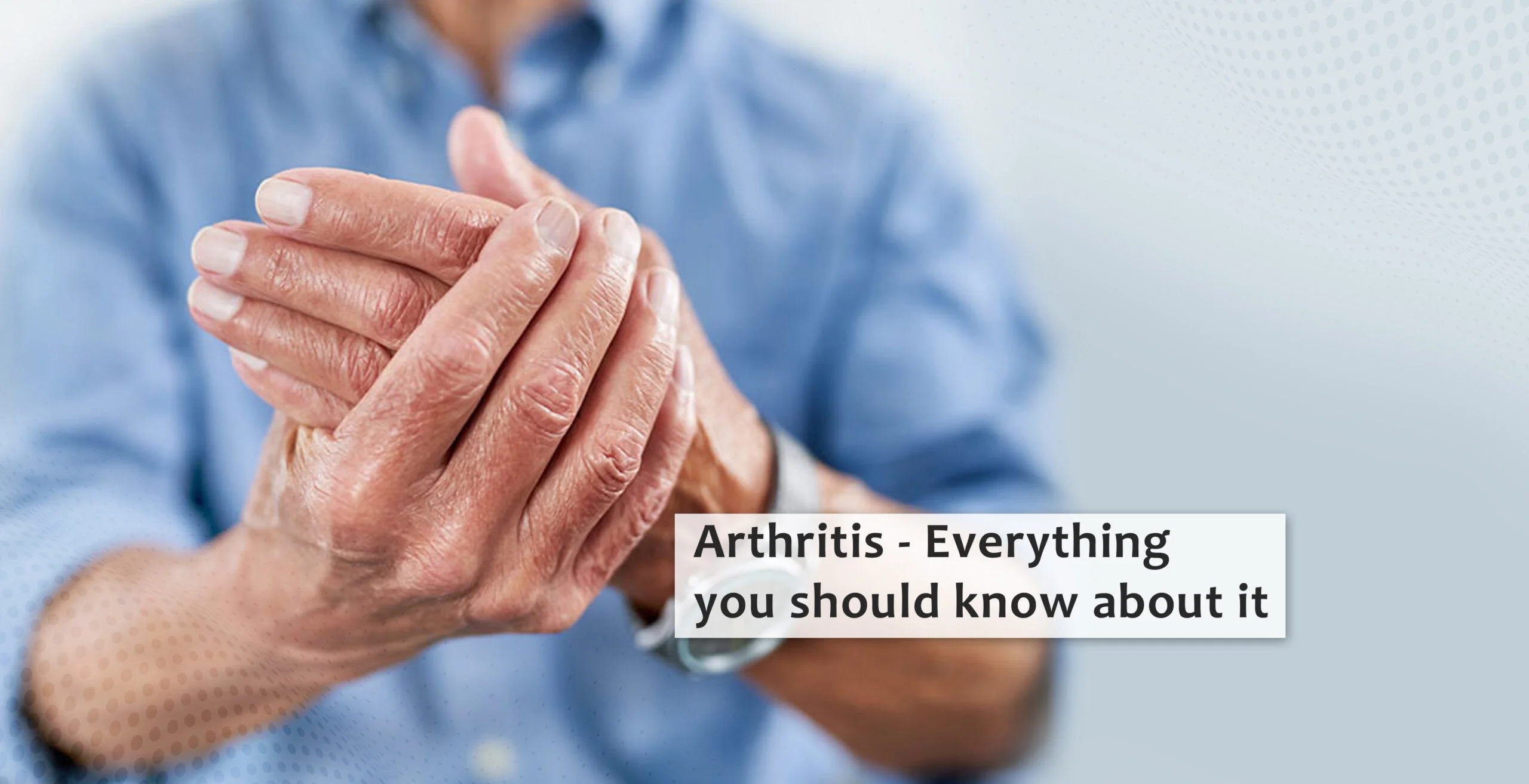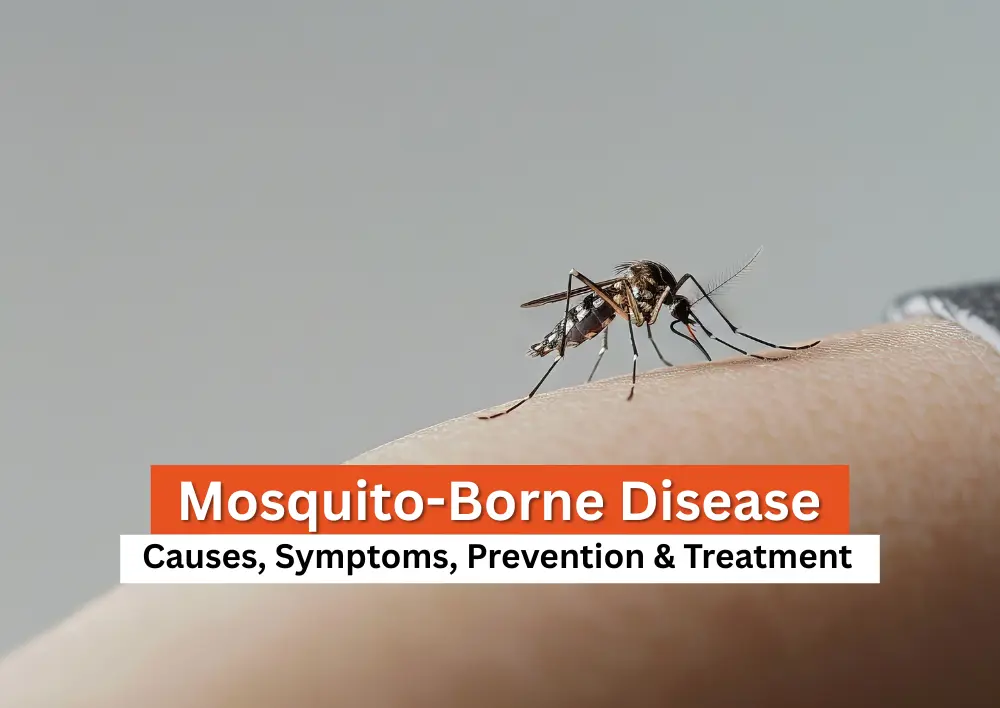Arthritis Everything You Should Know About It
Summary: Arthritis is a condition causing joint pain, stiffness, and swelling, commonly affecting older adults. The most common types include osteoarthritis, rheumatoid arthritis, Juvenile Idiopathic Arthritis, and gout. Its causes range from cartilage breakdown to autoimmune disorders, and symptoms include reduced joint mobility. Diagnosis involves medical exams, imaging tests, and joint fluid analysis, while treatment options include medications, therapy, and sometimes surgery. Early intervention can help manage arthritis symptoms and improve quality of life.
Struggling with joint pain or stiffness? Arthritis might be the culprit. It is a common condition that can cause pain, stiffness, and swelling in the joints. This condition can severely affect the quality of life and, in some cases, can even limit mobility. In this blog post, the leading orthopaedic doctor in gurgaon at Miracles Apollo Cradle/Spectra provides insight into everything you should know about arthritis, including its causes, types, symptoms, and treatment options.
Arthritis Definition
Arthritis refers to the inflammation of one or more joints, which are the areas where two or more bones meet. The inflammation can cause pain, stiffness, and swelling. It is a condition that can affect people of all ages, but it is more common in older adults. The term "arthritis" is a broad one, covering several different types of joint-related conditions.
WHO Arthritis Statistics
According to the World Health Organization (WHO), arthritis affects over 595 million people worldwide, with osteoarthritis being the most prevalent. In India, approximately 15% of the population is affected by arthritis. As the global population ages, the incidence of arthritis is expected to rise, making it an increasingly important health issue.
What Are the 7 Types of Arthritis?
Arthritis encompasses several different conditions, each with its own cause, symptoms, and treatment. Below are seven types of arthritis you should know about:
-
Osteoarthritis (OA): The most common type of arthritis, OA occurs when the protective cartilage that cushions the ends of the bones wears down over time. This leads to pain, swelling, and decreased joint flexibility. It commonly affects the joints of the knees, hips, and hands.
-
Gout: Gout is a form of arthritis that occurs due to the accumulation of uric acid crystals in the joints. This can lead to sudden and severe episodes of pain, usually affecting the big toe, ankles, or knees. Gout is often linked to diet, alcohol consumption, and obesity.
-
Rheumatoid Arthritis (RA): RA is an autoimmune disease in which the body's immune system attacks the lining of the joints. This leads to chronic inflammation, pain, and eventual joint damage. Rheumatoid Arthritis typically affects joints on both sides of the body, such as the wrists, knees, and fingers.
-
Viral Arthritis: In some cases, viruses can cause arthritis by infecting the joints. Conditions like hepatitis, rubella, or parvovirus can trigger viral arthritis, causing joint pain and swelling. This type of arthritis typically improves once the viral infection is treated. After a viral infection, post-viral arthritis may occur and often affects the large joints, such as the knees, and can last for weeks or months after the infection has passed.
-
Psoriatic Arthritis (PsA): PsA is a type of inflammatory arthritis that affects people with psoriasis, a skin condition that causes red, scaly patches. PsA can affect various joints, including the fingers, toes, and spine, leading to swelling and pain.
-
Juvenile Idiopathic Arthritis (JIA): JIA is the most common form of arthritis in children under the age of 16. It can lead to pain, swelling, and stiffness in the joint. While the exact cause remains unclear, it is thought to be an autoimmune disorder.
-
Inflammatory Arthritis: Inflammatory arthritis refers to a group of autoimmune conditions that cause the body’s immune system to attack healthy joints, leading to pain, swelling, and long-term joint damage. RA and PsA are two examples of inflammatory arthritis.
How Does Arthritis Happen?
Arthritis occurs when there is damage to the cartilage or tissues surrounding the joints. Cartilage is the smooth tissue that covers the ends of bones, allowing them to glide over each other. When cartilage breaks down, bones start rubbing against each other, leading to pain, inflammation, and further damage. In autoimmune types of arthritis, the body's immune system mistakenly attacks the joints, causing inflammation and damage.
When Does Arthritis Start?
Arthritis can develop at any age, although it is more commonly associated with older adults. The onset of arthritis generally occurs after the age of 40, with arthritis symptoms such as joint pain, stiffness, and swelling becoming noticeable over time. However, certain types of arthritis, such as juvenile arthritis, can affect children, and some forms may develop earlier in life.
Which Arthritis Is Dangerous?
Certain types of arthritis, such as rheumatoid arthritis and psoriatic arthritis, can be more dangerous if not managed properly. These conditions are autoimmune, meaning that the body attacks its tissues, leading to chronic inflammation and joint damage. Over time, this can result in permanent disability. Additionally, untreated gout can lead to joint deformities and kidney problems, while chikungunya arthritis can cause long-term joint pain and mobility issues.
Who Is at Risk of Arthritis?
Anyone can develop arthritis, but certain factors increase the risk:
-
Age: Older adults are more likely to develop arthritis, especially osteoarthritis.
-
Genetics: A family history of arthritis can increase the likelihood of developing it.
-
Gender: Women are more likely to develop rheumatoid arthritis and lupus, while men are more likely to develop gout.
-
Obesity: Excess weight puts additional stress on the joints, especially in weight-bearing areas like the knees.
-
Joint Injury: Previous joint injuries can increase the risk of developing arthritis later in life.
-
Other Health Conditions: People with other conditions, such as diabetes or high blood pressure, may be at higher risk of developing arthritis
Arthritis Tests: How Is Arthritis Diagnosed?
Diagnosing arthritis involves a combination of medical history, physical examination, and tests. The type of arthritis suspected will determine the specific tests required. Here are the most common tests used to diagnose different types of arthritis:
1. Blood Tests: Blood tests help identify markers of inflammation, infection, or autoimmune activity, which are common in certain types of arthritis.
-
Rheumatoid Factor (RF): Used to detect rheumatoid arthritis. A positive RF indicates the presence of rheumatoid arthritis but can also be positive in other autoimmune diseases.
-
Anti-Cyclic Citrullinated Peptide (Anti-CCP): Highly specific for rheumatoid arthritis. A positive result confirms the diagnosis.
-
Erythrocyte Sedimentation Rate: It measures inflammation in the body. High ESR levels indicate inflammation associated with conditions like rheumatoid arthritis or lupus.
-
C-Reactive Protein (CRP): Another marker of inflammation. High CRP levels suggest active inflammation, which can be seen in rheumatoid arthritis or psoriatic arthritis.
-
Uric Acid Test: High levels of uric acid in the blood may indicate gout.
-
Complete Blood Count (CBC): Checks for anemia, which is common in rheumatoid arthritis and lupus.
2. Imaging Tests: Imaging tests help visualize joint damage, inflammation, and structural abnormalities.
-
X-rays: Detect joint damage, bone erosion, and narrowing of joint spaces seen in osteoarthritis and rheumatoid arthritis.
-
Magnetic Resonance Imaging (MRI): Provides detailed images of soft tissues, including cartilage, tendons, and ligaments. It is useful for detecting early joint damage and inflammation.
-
Ultrasound: Helps visualize joint inflammation, fluid accumulation, and synovitis (inflammation of the joint lining). It is particularly useful for rheumatoid arthritis and gout.
-
CT Scan: Offers detailed cross-sectional images of bones and joints, mainly used for complex joint issues.
3. Joint Fluid Analysis (Arthrocentesis): A small amount of fluid is withdrawn from the affected joint using a needle. The fluid is analyzed for:
-
White Blood Cells (WBCs): A high WBC count indicates inflammation or infection.
-
Crystals: The presence of uric acid crystals confirms gout, while calcium pyrophosphate crystals indicate pseudogout.
-
Bacteria: Indicates septic arthritis if infection is present.
4. Physical Examination and Medical History
-
Physical Exam: The doctor checks for joint swelling, redness, warmth, and range of motion.
-
Medical History: A detailed history of symptoms, family history of arthritis, and any previous injuries are taken into account.
5. Specialized Tests
-
HLA-B27 Test: Used to detect a genetic marker associated with ankylosing spondylitis and other inflammatory arthritis types.
-
Antinuclear Antibody (ANA) Test: Used to detect autoimmune diseases like lupus that can cause arthritis-like symptoms.
Arthritis Treatment
Arthritis treatment varies depending on the type and severity of the condition. Early diagnosis and personalized care can significantly improve the quality of life for those affected by arthritis. The treatment options include:
1. Osteoarthritis Treatment
Osteoarthritis Symptoms:
-
Joint pain and stiffness
-
Swelling and tenderness around the joint
-
Loss of flexibility
-
A grating sensation or crackling sound with movement
Treatment Options:
-
Pain Relief: Over-the-counter pain relievers like acetaminophen or nonsteroidal anti-inflammatory drugs (NSAIDs) such as ibuprofen.
-
Physical Therapy: Exercises to strengthen muscles around the joint, improving flexibility and reducing pain.
-
Lifestyle Changes: Weight management to reduce joint stress, low-impact exercises like swimming or cycling.
-
Assistive Devices: Braces or shoe inserts to support affected joints.
-
Surgery: In severe cases, joint replacement or repair surgery may be recommended.
2. Rheumatoid Arthritis Treatment
Rheumatoid Arthritis Symptoms:
-
Swollen, tender, and warm joints
-
Stiffness, especially in the morning or after inactivity
-
Fatigue, fever, and loss of appetite
-
Symmetrical joint pain (affects both sides of the body)
Treatment Options:
-
Medications:
-
Disease-modifying antirheumatic drugs (DMARDs) like Methotrexate to slow disease progression.
-
Biologic agents that target particular parts of the immune system.
-
NSAIDs and corticosteroids for pain and inflammation.
-
-
Physical Therapy: Exercises to maintain joint flexibility and muscle strength.
-
Lifestyle Changes: Balanced diet, adequate rest, and stress management.
-
Surgery: Joint replacement or tendon repair in severe cases.
3. Viral Arthritis Treatment
Viral Arthritis Symptoms:
-
Joint pain and swelling
-
Fever and fatigue
-
Rash in some viral infections
-
A general feeling of being unwell
Treatment Options:
-
Rest and Hydration: To help the body fight off the virus.
-
Pain Relief: NSAIDs like ibuprofen or acetaminophen for pain and fever.
-
Antiviral Medications: In cases like Hepatitis B or C, antiviral drugs may be necessary.
-
Physical Therapy: Gentle exercises to maintain joint mobility once the acute symptoms subside.
-
Self-care: Applying cold packs to reduce swelling and pain.
4. Gout Treatment
Gout Symptoms:
-
Sudden, severe joint pain, usually starting in the big toe
-
Swelling, redness, and warmth in the affected joint
-
Limited movement in the affected area
-
Lingering discomfort after an acute attack
Treatment Options:
-
Acute Attack Relief: NSAIDs, colchicine, or corticosteroids to reduce pain and inflammation.
-
Long-term Management: Uric acid-lowering medications like allopurinol or febuxostat.
-
Lifestyle: Changes include reducing alcohol and eating purine-rich foods (red meat, seafood).
-
Hydration: Staying well-hydrated by drinking plenty of water helps eliminate uric acid.
-
Dietary Adjustments: Eating more low-fat dairy, vegetables, and whole grains.
5. Chikungunya Arthritis Treatment
Chikungunya Arthritis Symptoms:
-
Severe joint pain usually in the hands and feet
-
Fever and fatigue
-
Rash and muscle pain
-
Joint swelling and stiffness
Treatment Options:
-
Pain Relief: Paracetamol or NSAIDs for pain and fever.
-
Hydration and Rest: To help the body recover from the virus.
-
Physical Therapy: Gentle exercises to restore joint mobility after the acute phase.
-
Supportive Care: Applying cold packs to relieve joint pain.
6. Inflammatory Arthritis Treatment
Inflammatory Arthritis Symptoms:
-
Joint pain and swelling
-
Morning stiffness lasting more than an hour
-
Fatigue and general feeling of illness
-
Redness and warmth in the affected joints
Treatment Options:
-
Medications:
-
DMARDs to slow disease progression.
-
Biologic agents targeting the immune system.
-
NSAIDs and corticosteroids for pain and inflammation.
-
-
Physical Therapy: Exercises to improve joint function and muscle strength.
-
Lifestyle Changes: Anti-inflammatory diet, stress management, and adequate rest.
-
Surgery: In severe cases, joint replacement or corrective surgery may be needed.
7. Cervical Arthritis Treatment
Cervical Arthritis Symptoms:
-
Neck pain and stiffness
-
Headaches, especially at the back of the head
-
Numbness or tingling in the arms or hands
-
Muscle weakness in the shoulders, arms, or hands
Treatment Options:
-
Pain Relief: NSAIDs, muscle relaxants, or corticosteroid injections.
-
Physiotherapy: Physiotherapy exercises to strengthen neck muscles and improve posture.
-
Heat and Cold Therapy: To relieve pain and muscle spasms.
-
Lifestyle Changes: Maintaining proper posture, and ergonomic adjustments at work.
-
Surgery: In severe cases, surgery may be important to relieve nerve compression.
8. Septic Arthritis Treatment
Septic Arthritis Symptoms:
-
Severe joint pain, swelling, and redness
-
Fever and chills
-
Limited range of motion in the affected joint
-
Warmth around the joint area
Treatment Options:
-
Antibiotics: Intravenous antibiotics to treat the infection.
-
Joint Drainage: Using a needle to remove infected fluid from the joint.
-
Rest and Immobilization: To reduce pain and swelling.
-
Surgery: In severe cases, surgical cleaning of the joint may be required.
-
Physical Therapy: To restore joint mobility after the infection is controlled.
9. Juvenile Idiopathic Arthritis (JIA) Treatment
Juvenile Idiopathic Arthritis Symptoms:
-
Joint pain, swelling, and stiffness
-
Fatigue and fever
-
Eye inflammation (uveitis) in some cases
-
Limping or difficulty using affected joints
Treatment Options:
-
Medications:
-
NSAIDs for pain relief.
-
DMARDs and biologics to control inflammation and prevent joint damage.
-
-
Physical Therapy: Exercises to maintain joint function and muscle strength.
-
Occupational Therapy: Assistance with daily activities and use of assistive devices.
-
Healthy Lifestyle: Balanced diet, adequate rest, and maintaining an active lifestyle.
-
Surgery: Rarely required but may be needed for joint repair or replacement.
Conclusion:
Arthritis can significantly impact daily life, but understanding its types, causes, and treatment options can help you take control. If you or someone you know is experiencing joint pain or stiffness, don’t wait, consult an ortho doctor near you at Miracles Healthcare for an accurate diagnosis and tailored treatment plan. With the right care and lifestyle adjustments, living well with arthritis is possible. Remember, early action and staying active can make a big difference in managing arthritis effectively.



_कारण,_लक्षण,_इलाज_और_बचाव.webp)









Was the information useful?
0 0